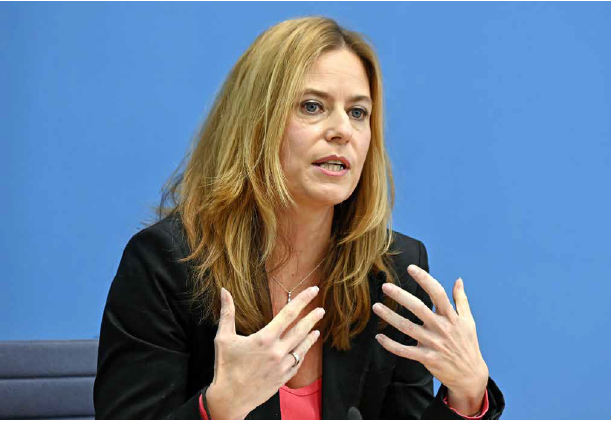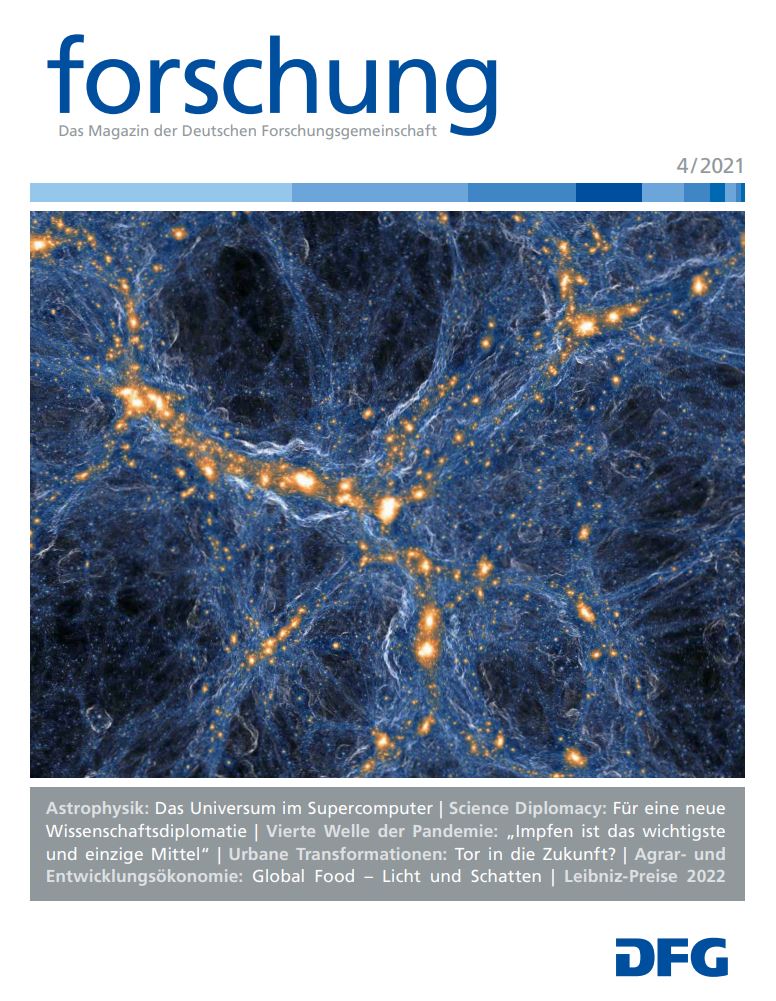“Vaccination is the Most Important Remedy – and the Only Remedy”

Prof. Dr. Susanne Herold
© dpa/POOL NEW
Germany in the fourth wave of the coronavirus pandemic: infectious diseases and lung specialist Susanne Herold, member of the DFG Commission for Pandemic Research, on the “pandemic of the unvaccinated”, “vaccine mandate for all”, current SARS-CoV-2 studies and lessons learned in health communication.
Interview: Dr. Rembert Unterstell, german research.
german research: Professor Herold, we’re conducting this interview in the second week of December, in the middle of the dramatic fourth wave of the pandemic. What is the situation in the intensive care units at Gießen University Hospital?
Susanne Herold: We’re doing comparatively well in that the rate of infection in the district of Gießen is currently below 200. Nevertheless, we’re working to full capacity and under strain in the intensive care units (ICU) because the clinical situation is different from that of the second or third wave. We now have fewer COVID-19 patients to look after – but we’re not able to take on more because we’ve been up to 25 percent short of intensive care staff at the hospital in some cases. As in many intensive care units, we’re working at the limit.
What changes have you been seeing with the Delta variant in terms of the age of your COVID-19 patients and the progress of the disease?
The patients are getting younger – not because Delta is causing a substantially different disease but because more older people are vaccinated. We’re now mainly treating middle-aged people who are not vaccinated. We rarely have children, unless they have pre-existing conditions. We can now influence the progression of the disease somewhat more effectively by means of monoclonal antibody therapies, but these are still not ideal.
Is the impression deceptive that at the beginning of the pandemic the life-threatening lung problems associated with severe COVID-19 progressions were predominant, but that other consequences of the disease are now more prevalent – affecting the brain, the vascular system and the psyche?
Nothing has changed in terms of the clinical pattern of the disease. But we do now have more data regarding the Long Covid symptom complex. SARS-CoV-2 is primarily a viral disease of the lungs, but other organ systems can also be affected. It is particularly striking that COVID-19 infections differ from other virusinduced lung infections such as influenza. We’re only just beginning to understand the molecular mechanisms involved here.
You’ve led the Clinical Research Unit “Virus-Induced Lung Failure” since 2017: have you come up with any findings with regard to SARS-CoV-2 that have surprised you?
We’ve not only been conducting research into coronaviruses since the beginning of the pandemic. What has surprised us in the current Clinical Research Unit is that there are specific signatures in SARS-CoV-2 (i.e. a specific inflammatory profile in infected cells, but also in the organism as a whole – editor’s note): the impact of these on the symptoms of the disease and its severity are still unclear. We’re seeing that the excessive immune responses to COVID-19 differ from those associated with influenza. This is also where the macrophages (i.e. phagocytes and leukocytes in the immune system – editor’s note) come into play: as a researcher, these have long been among my favourites. In the Research Unit, we’ve also extended some questions and projects to include SARS-CoV-2 and are working on translational approaches – such as preliminary studies for an immunomodulatory drug – and we’re also conducting a number of phase 2 clinical trials aimed at improving the macrophage-based immune response and promoting organ repair after lung injury.
How do you assess the risk potential of Omicron as an immune escape variant?
There seem to be more than 30 mutations in the spike protein where the targets for the antibodies are located; this means there’s a significant probability that the antibodies acquired through vaccination or infection do not work well, so we have to assume limited immunity. To put it simply, the antibody response is not the only key factor in our immune system: T cell immunity is vital, too. The significance of this in terms of the rate of infection is a matter of speculation and requires further data. But this is something many scientists are already concerned about. The main thing now is to slow the spread of Omicron by means of vaccination and boosting, while hoping that an adapted vaccine will be available soon.
From your clinical point of view, can we speak of a “pandemic of the unvaccinated”?
Yes, at the moment that is absolutely the case.
The lagging peak for ICU is expected in January. Will it still be possible to slow down the hospitalisation rate by means of the vaccination and booster campaigns combined with contact restrictions?
We’re actually expecting an increase in new infections as a result of contacts over the holidays. The number of severely ill COVID-19 patients and those requiring intensive care lags behind the infection rate. But one thing we are seeing – and this is said too rarely – is that most people do stick to the rules. In my social environment, I’m seeing that people have become much more cautious again in view of the frightening infection and fatality rates. Together with 2G rules and an increase in second vaccinations and booster jabs, this will hopefully lead to an easing of the situation and we’ll at least enter a sustained plateau phase in terms of hospitalisation figures.
What is important now?
There are a number of interrelated factors, also at the regional level: it will be crucial to increase the vaccination rate quickly; whether the planned 30 million vaccina-tions can be achieved by the end of the year remains to be seen. In retrospect, I believe it was wrong to close the vaccination centres from the summer onwards and not to drive the vaccination campaigns earlier and more consistently when we realised that vaccination rates were stagnating below 70 percent. Vaccination is the most important remedy – and the only remedy – that will enable us to bring the pandemic situation to an end, and of course the day-to-day hygiene rules must continue to be observed even as vaccination rates rise. But ultimately, as always, it’ll come down to each individual’s insight and common sense.
Why were you one of the co-signatories of an urgent letter sent to politicians by 35 scientists in mid-November?
There were clear scientific predictions about how the pandemic would develop, which were then fulfilled almost 1:1. It was obvious that we had to achieve a significantly higher vaccination rate. More preparations should have been made, a forward-looking pandemic policy should have been pursued – but this didn’t happen because it didn’t seem opportune.
Political observers suspect that since the summer of 2021 there has been a denial of reality and a sense of unconcerned wishful thinking among political lead-ers (the notion of “Freedom Day”) – combined with an unwillingness to take unpopular pandemic measures during an election campaign and before the government was formed ...
Yes, that’s how I see it too. That was why I signed the letter. After almost two years, people are tired, worn down and long for normality – if you proclaim the end of the pandemic, it’s a message that’s bound to fall on fertile ground.
What is your personal position on the much-debated vaccine mandate?
I never imagined that we’d have such difficulties in achieving high vaccination rates in Germany. We received the first vaccine doses delivered to Gießen Hospital on 26 December 2020 – we were so grateful and happy to be able to start vaccinating right away. Since that time, the perception of vaccination has changed considerably. Yes, I do believe we need a vaccine mandate now – not only for specific workers in hospitals and care facilities but for everyone.
As a member of the DFG Commission on Pandemic Research, you contributed to the dossier “Know more, make informed decisions” published in January 2021. In the face of the unnerving debate on vaccines and vaccinations, does educational health communication need to be approached differently, or indeed entirely reconceived?
A new approach has to be taken to communication at very different levels. One lesson we’ve learned is that public and media communication has failed to some extent. It’s not just about conveying facts – it has a lot to do with psychology, too. We need to study how communica-tion can be improved. By now we might assume that almost every citizen is aware of the important facts about vaccination. Far from it! Besides those who are genuinely opposed to vaccination and the relevant government regulations, there are many people who simply don’t use television, newspapers or social media and are completely out of reach due to cultural and linguistic barriers. On ward rounds and when asking unvaccinated COVID-19 patients at their bedside, I hear again and again: “I didn’t know all that – if someone had explained it to me like that I would have got vaccinated!”
Looking ahead to 2022, what is the lesson from the pandemic that you would like to focus on?
In medicine, we need better research infrastructures that can make third-party funds available for longer periods of time – longer than the one-year horizon – so as to be able to act more swiftly in basic research and translation. Short-term new and renewal proposals cost a lot of energy and time – and pose a major problem for clinical trials. And we must continue to invest in targeted basic research. The mRNA vaccines would not have been possible without decades of fundamental work.
What is your wish for the New Year in relation to the pandemic?
(laughs) I have several! My wish as a clinician and for the people is, of course, to take the chance now to get vaccinated promptly before we run into a new wave of Omicron. My wish for the funding institutions is make plannable funds available so as to be able to combine basic research and translational research on a lasting basis. And finally, I’d like to see policy makers listen to scientists and clinical practitioners more closely and make better use of what they say – not least with a view to an evidence-based pandemic policy.
Thank you very much for taking the time for this interview!
Further Information

The interview was published in the
English version of the interview is available in the